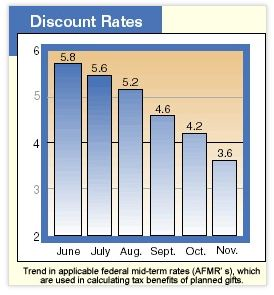The stock market boom of the 1990s led to a surge in gifts of appreciated stock. In fact, in recent years “gifts of appreciated property” have seemed synonymous with “gifts of appreciated stock,” particularly for gift planners that entered the field during that time period.
The recent downturn in stock market indexes has left many gift planners hesitant to suggest gifts of appreciated property, but this need not be the case. When viewed over the long term, for example, significant appreciation remains in the stock market for long-term investors. Gift planners should also note that, according to Internal Revenue Service statistics, stocks represent a small portion of the typical assets listed on estate tax returns and are just one category of property that may be given.
The continuing increases in the value of real estate, bonds, and other property have largely served to offset reductions in the stock market. According to the most recent figures available, total household wealth peaked in 1999 at $42.4 trillion. At the end of the second quarter of 2002, the total was still $40.1 trillion, some 95% of the peak of asset values.
Gifts beyond the norm
In challenging times, development executives of the nation ’s nonprofits need to search for nontraditional gifts to help replenish reserve funds, enhance endowments, and provide for operating
Real estate. The Wall Street Journal recently ran an article highlighting a marked increase in gifts of real estate, and many Sharpe clients have noticed the trend as well (see page 3).
In addition to outright real estate gifts, deferred gifts funded with real property may make sense for some donors. For example, life estate arrangements involving a farm or personal residence can generate significant income tax savings that would not be available to the donor if the property were left to the charity as a bequest. And the relatively recent addition of the FLIP unitrust to the gift planner ’s toolbox increases the attractiveness of funding charitable remainder trusts with real estate.

Bonds. The typical investor holds bonds until maturity as a source of income flow and therefore derives no benefit from capital gain appreciation that the bond may experience over time. However, appropriate charitable giving strategies can allow the donor to realize the benefits of this appreciation on a tax-advantaged basis.
For example, a donor may give appreciated bonds held longer than one year and claim a deduction for their full value, just as in the case of a gift of appreciated stock, or the donor may use highly appreciated, low-yielding bonds to fund a gift that provides income. Consider the case of a $100,000 long-term debt instrument that originally paid 10% per annum. As interest rates have fallen, the “value ” of the bond has increased to $200,000,but the effective yield has fallen to 5%. Depending upon the donor ’s age and other factors, the bonds might be used to fund a life income arrangement that could easily provide 20-40% more cash flow and a significant current income tax deduction. (Note: different rules apply to U.S. savings bonds.)
Gifts of tangible personal property. Recently, trustees of the Whitney Museum in New York contributed artwork valued at $200 million to the museum. By arranging the gifts during their lifetimes, they receive significant income tax savings and enjoy the satisfaction of giving that might not be achieved through an estate gift.
In another reported case, an individual used a rare Aston Martin automobile that had been purchased for $5,000 in 1969 to fund a charitable remainder trust. The trustee sold the car for $1 million! This win-win situation for the donor and the charity allowed the donor to convert a non-income-producing asset into a retirement income stream and avoid a capital gains tax liability of nearly $280,000.*
The key to appreciating gifts of property may lie in recognizing that donors may accumulate a variety of assets over the course of a lifetime, many of which may make advantageous gifts. Remember the old fundraising adage that successful fundraisers should “find out what donors own and ask them for one of them.” Although these gifts may involve appraisals, reviews by a gift acceptance committee, and other steps not involved in more traditional gifts, gifts of appreciated property will also become increasingly important in today ’s challenging fundraising environment.
*The general reduction of the capital gains rate from 28% to 20% provided for in the 1997 tax act was not extended to “collectibles” like the automobile in this example.

